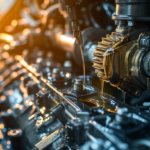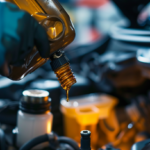Last Updated on 13 August 2023 by Lucas
Are you aware of the importance of checking your car’s fluid levels regularly? Maintaining proper levels of engine oil, coolant, transmission fluid, brake fluid, windshield washer fluid, battery fluid, and differential fluid is crucial for the smooth functioning and longevity of your vehicle. In this article, we will guide you through the simple steps to check and maintain these essential fluids. By following these instructions and incorporating them into your regular maintenance routine, you can ensure a safe and well-functioning car.
The Importance of Regularly Checking Your Car’s Fluid Levels
You should regularly check your car’s fluid levels to ensure proper maintenance and prevent potential issues. The importance of regular maintenance cannot be overstated when it comes to keeping your vehicle in good working condition. By checking the fluid levels, you can identify any leaks or low levels that may indicate a problem. This simple task can save you from costly repairs down the road.
In addition to preventing issues, there are also benefits of hiring a professional mechanic for regular maintenance. They have the expertise and knowledge to accurately assess your car’s fluid levels and make any necessary adjustments or repairs. They can also provide valuable advice on how often certain fluids need to be changed or topped up.
Overall, taking the time to check your car’s fluid levels is a small but crucial part of maintaining your vehicle’s performance and longevity. Don’t overlook this important aspect of car care!
Engine Oil: How to Check and Maintain the Right Level
To maintain the right level of engine oil, start by checking the dipstick. Regular oil changes are crucial for keeping your car running smoothly and preventing costly repairs. When you fail to change the oil on time, it can become dirty and lose its lubricating properties. This can lead to increased friction between the moving parts of your engine, causing excessive wear and tear. It’s important to check your engine oil levels regularly to ensure they are not too low. If you notice signs such as a burning smell or unusual noises coming from your engine, it could indicate low oil levels. Ignoring these signs can result in severe damage to your engine. By taking a few minutes to check and maintain the right level of engine oil, you can prolong the life of your vehicle and avoid expensive repairs down the road.
Coolant: Prevent Overheating by Checking the Coolant Level
Regularly checking the coolant level is essential for preventing overheating in your vehicle. To ensure that your car’s engine stays cool and functions properly, it is crucial to maintain the right amount of coolant. Here are four key steps to help you check and maintain the coolant level:
- Park your car on a flat surface and let the engine cool down completely.
- Locate the coolant reservoir, usually marked with “coolant” or “engine coolant.”
- Check the level by looking at the markings on the reservoir. If it is below the minimum mark, add a 50/50 mixture of coolant and water until it reaches the appropriate level.
- Keep an eye out for signs of low coolant levels, such as overheating, steam coming from under the hood, or a sweet smell inside your car.
By incorporating these preventive maintenance practices into your routine, you can avoid potential engine damage caused by overheating due to low coolant levels.
Transmission Fluid: Ensure Smooth Gear Shifting with Proper Fluid Levels
Make sure the transmission fluid in your vehicle is at the correct level to ensure smooth gear shifting. Preventing gear slippage is vital, and checking the transmission fluid regularly plays a crucial role in achieving this. Transmission fluid serves as a lubricant, ensuring all the moving parts inside your car’s gearbox work seamlessly together. By maintaining optimal performance through proper transmission fluid levels, you can avoid costly repairs and extend the lifespan of your transmission system.
Regularly checking and topping up the transmission fluid will help prevent gear slippage, which occurs when gears fail to engage properly. This issue can lead to inefficient power transfer, jerky movements, or even complete loss of power. On the other hand, ensuring adequate levels of transmission fluid allows for smoother shifting between gears and overall improved performance.
In summary, don’t overlook the importance of checking your car’s transmission fluid regularly. Doing so will help prevent gear slippage and maintain optimal performance for a long-lasting and trouble-free driving experience.
Brake Fluid: Maintain Braking Efficiency by Checking the Fluid Level
Ensure your vehicle’s braking efficiency by maintaining the proper level of brake fluid. Brake fluid is a crucial component for effective and safe braking. Without enough brake fluid, you may experience various issues that can compromise your ability to stop quickly and smoothly. Low levels of brake fluid can lead to a spongy or soft brake pedal, increased stopping distances, and even complete brake failure in extreme cases. To troubleshoot common issues with brake fluid, start by checking the reservoir to ensure it is filled to the recommended level. If you notice any signs of low brake fluid levels such as a warning light on your dashboard or a decrease in braking performance, it’s essential to address the problem immediately. Regularly inspecting and topping up your brake fluid will help maintain optimal braking efficiency and keep you safe on the road.
Power Steering Fluid: Keep Steering Smooth by Checking and Topping up the Fluid
Keep your steering smooth and responsive by regularly checking and topping up the power steering fluid in your vehicle. This is an important maintenance task that ensures your power steering system functions properly. Here are three things to keep in mind when dealing with power steering fluid:
-
Topping up power steering fluid: If you notice that the level of the power steering fluid is low, it’s important to top it up as soon as possible. Low fluid levels can lead to increased effort required for steering, causing strain on your arms and wrists.
-
Signs of low power steering fluid: Keep an eye out for signs like difficulty turning the wheel or a squealing noise when you turn. These could indicate low power steering fluid levels and should be addressed promptly.
-
Checking the power steering fluid: Locate the reservoir under the hood labelled “power steering.” Remove the cap and use a dipstick or inspection window to check if the fluid level is between the minimum and maximum markings.
By following these steps, you can ensure that your power steering system remains in good working condition, providing you with smooth and effortless control over your vehicle’s direction.
Windshield Washer Fluid: Ensure Clear Visibility by Checking and Refilling the Fluid
Now that you’ve learned how to keep your steering smooth by checking and topping up the power steering fluid, let’s move on to another important fluid for clear visibility: windshield washer fluid. Regularly checking and refilling the windshield washer fluid is crucial in preventing visibility issues while driving. This fluid is specifically designed to clean your windshield and remove dirt, dust, and other debris that can obstruct your view. By ensuring that this fluid is always at an appropriate level, you can confidently drive knowing that you have a clear line of sight on the road ahead. So don’t forget to regularly check and refill your windshield washer fluid to maintain optimal visibility and keep yourself safe on the road.
Battery Fluid: Extend Battery Life by Checking and Topping up the Electrolyte Levels
To extend the life of your battery, make sure to regularly top up the electrolyte levels. The electrolyte is a mixture of water and sulfuric acid that helps facilitate chemical reactions within the battery. Over time, these levels can decrease due to evaporation or loss during charging cycles. To check the electrolyte levels, remove the caps from each cell in the battery and visually inspect the fluid. It should cover the lead plates inside, but not overflow. If it’s low, carefully add distilled water until it reaches the appropriate level. Avoid overfilling as this can cause damage to your battery. By maintaining proper electrolyte levels, you ensure that your battery operates efficiently and effectively, ultimately extending its overall lifespan and saving you money in replacement costs.
Differential Fluid: Maintain Proper Lubrication by Checking the Differential Fluid
Make sure you regularly inspect and maintain the proper lubrication of your differential fluid to ensure optimal performance. The differential is an essential component in your car’s drivetrain, responsible for transferring power from the engine to the wheels. By checking and maintaining the differential fluid, you can prevent costly repairs and extend the lifespan of your vehicle. Signs of low differential fluid include strange noises coming from the rear end of your car, difficulty turning or steering, and a burning smell. If you notice any of these signs, it’s important to check your differential fluid levels immediately. To do so, locate the differential fill plug on the rear axle housing and remove it. Use a dipstick or your finger to check if the fluid level is within the recommended range. If it’s low, add more fluid until it reaches the appropriate level. Regularly maintaining your differential fluid will help ensure smooth driving and optimal performance of your vehicle.
Regular Maintenance Schedule: Create a Routine for Checking and Maintaining Fluid Levels
Creating a regular maintenance schedule is essential for ensuring that the fluid levels in your vehicle are consistently checked and maintained. By creating a checklist for regular fluid maintenance, you can stay on top of this important task. Start by checking your engine oil, transmission fluid, coolant, power steering fluid, and brake fluid regularly. Each type of fluid plays a crucial role in keeping your car running smoothly. It’s also important to know how to identify common fluid problems. Look out for signs such as low levels, leaks, or unusual colours or smells. These could indicate a potential issue that needs to be addressed promptly. Regularly maintaining your car’s fluid levels will not only help prevent major problems but also contribute to the overall longevity and performance of your vehicle.

Lucas is an experienced vehicle technician with hands-on knowledge of almost every car brand available. Throughout his career, Lucas has worked on a wide range of vehicles, including domestic and foreign models, sports cars, trucks, and SUVs.




